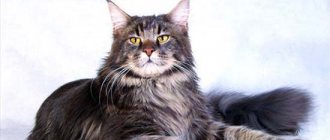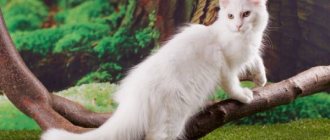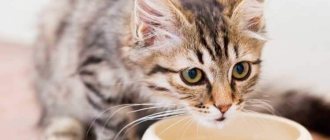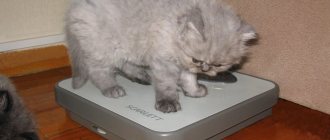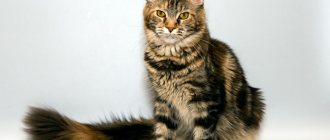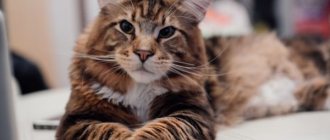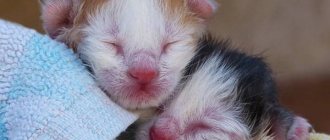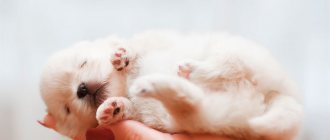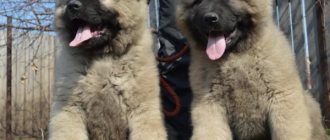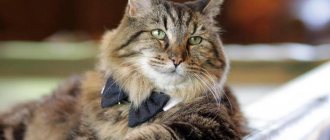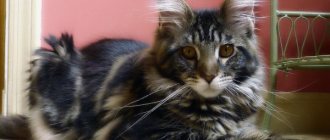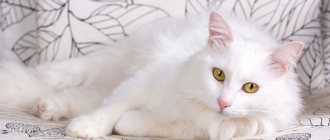Adult Maine Coons are famous for their large size and considerable weight for a domestic cat. And many people who have only recently become owners of babies of this breed are perplexed when looking at their funny, playful and still very small pet. Will he, too, someday turn into a huge, important and at the same time graceful cat? How do kittens grow and what factors can influence the size they eventually reach when they finally become adults?
Factors influencing growth
- Floor. Boy kittens grow faster than girl kittens and, as a result, when they finally mature, they reach larger sizes than their sisters.
- Genetics. Kittens from large parents are born with greater body weight and, as a rule, also grow up to be as large as their relatives.
- Physical condition of the newborn. Babies born weaker gain weight less quickly.
- Large litter size. Kittens from small litters are born larger than kittens from larger litters.
- Maintenance of mother kittens during pregnancy and while feeding offspring. If a mother cat eats properly and is kept in good conditions, then she produces healthy and strong offspring, which is the key to good growth and weight gain in babies.
- Stress. If there is a turbulent atmosphere in the house where the pet is growing up, if the owners are arguing, starting renovations, or something else is happening in their family that disrupts the usual rhythm of life in the house, then the kitten will gain weight worse due to strong worries.
- Past illnesses. Kittens that have recovered from the disease grow worse, and their growth may stop altogether for some time.
- Feeding. In order for a pet to grow well, it must eat properly and nutritiously.
Heredity depends not only on the mother of the kittens, but also on the father, so from different cats the same cat can produce offspring of different sizes.
They don't like loneliness
Maine Coons always strive for the room where there is a person; without attention, they suffer greatly. They, as a rule, choose one owner and remain devoted to him for life. If your cat chose you out of all the family members, then you are very lucky, but there are disadvantages: he is unlikely to give you privacy in the toilet or shower. The doors in the room you are in should always be open. These animals generally hate loneliness: even if you leave the house for just a couple of hours, the Maine Coon will greet you with violent screams. But cats of this breed are easy to teach dog tricks. Our pet always comes when called and knows how to fetch. Some owners even boast that they taught their pet the “sit” command. It’s better for you to always be close, otherwise they may be offended by you and will never let you caress them again. Therefore, either take it with you always or don’t start it at all.
Video
Video from the exhibition, breeder's opinion.
Below are photos of the kitten's development by month.
5 weeks.
1.5 months.
2 months.
3.5 months.
5 months.
7 months.
10 months.
11 months.
1 year and 2 months.
Kitten development
During its maturation, a growing kitten goes through four stages of growth:
- Neonatal period. This is also the period of the newborn. It usually lasts 4 days. During this time, the daily weight gain of the cat's cubs depends on how easy their mother's birth was.
- Suction period. Lasts 1 month. During this time, kittens, on average, gain from 20 to 50 grams of weight daily.
- Transition period. It begins from the time the cat cubs begin to eat a little on their own and continues until about one and a half to two months (7-8 weeks of life). At this time, the rate of weight gain slows down somewhat.
- After the suckling period. The kittens are weaned from their mother, the cat, and feed completely on their own. They begin to gain weight and height again quite quickly. This stage lasts from approximately one and a half months until the little Maine Coon becomes a full adult.
Cats of this breed mature and gain weight until about the age of three.
They also grow up to the age of 3 years. It is during this period that physiological and psychological maturation occurs, as well as puberty. For about another year or two the cat will continue to “matrate.” Muscle mass will increase, he may gain a little weight, and his chest will expand. At the age of 4–5 years they are active and full of energy.
What do they look like?
Those who have ever seen the breed of these cats cannot help but admire Maine Coons. If we briefly characterize this breed, they are:
- fluffy;
- reach large sizes;
- very beautiful and simply magnificent.
The cat's height is normal, but the length of the Maine Coon is quite impressive and can reach one meter if measured from the nose to the tip of the tail. If we talk about the weight of an adult, it may differ depending on gender:
- an adult cat weighs up to eight to ten kg;
- The cat's weight is slightly less and is four to seven kg.
© shutterstock
But why then do Maine Coons seem to weigh so much more? You may have even heard that they can weigh up to twenty kilograms! All this, of course, is not true. But, as they say, there is no smoke without fire. These cats seem to have an impressive weight because:
- their body is slightly elongated;
- the muscles are very well developed;
- the neck and shoulder girdle are quite massive.
Mass table by month
| Kitten age | Cat weight (in grams) | Cat weight (in grams) |
| 1 month | 630 - 750 g | 560 - 680 g |
| 2 months | 1230 - 1500 g | 1150 - 1400 g |
| 3 | 1800 - 2300 g | 1700 - 2300 g |
| 4 | 3000 - 3800 g | 2700 - 3600 g |
| 5 months | 3200 - 5500 g | 2900 - 3900 g |
| 6 | 3900 - 6500 g | 3200 - 4000 g |
| 7 | 4200 - 6500 g | 3500 - 4300 g |
| 8 | 4500 - 6900 g | 3800 - 4300 g |
| 9 | 5000 - 7000 g | 4100 - 5000 g |
| 10 | 5200 - 7500 g | 4200 - 5500 g |
| 11 | 5700 - 8000 g | 4300 - 6000 g |
| 1 year | 5700 - 9000 g | 4500 - 6300 g |
| 1.5 years | 6000 - 9500 g | 4500 - 6500 g |
| 2 years | up to 10,000 g | 4500 - 7000 g |
| 2,5 | up to 12,000 g* | 4500 - 7200 g |
| 3 | up to 13,000 g* | up to 7500 g |
* Up to 12,000 - 13,000 g - the weight of adult castrated cats.
What to do if the kitten is not gaining weight?
If the kitten has stopped gaining weight, first of all, you need to find out the reason why this is happening. If a slight weight gain is associated with improper feeding (possibly from the breeder), then the new owner of the furry baby needs to take the following measures:
- Add more high-calorie foods to your pet's food, and also increase the amount of animal proteins.
- If your pet eats ready-made food, then you can try to switch it to food richer in proteins and higher in calories, preferably of a better class than the previous one.
- Start giving your pet vitamin and mineral supplements (preferably complex ones, which contain the entire necessary set of microelements).
Without consulting a veterinarian, you should not give your kitten biologically active additives to increase appetite or, especially, drugs that artificially increase body weight.
Also, in all cases, if a kitten’s poor weight gain is not related to nutrition, but to reasons other than genetic, it makes sense to take the pet to a veterinary clinic for a consultation and examination.
Character and characteristics of the Maine Coon breed
The appearance of the Maine Coon is so unique that it is difficult to confuse it with other representatives of the cat family. If you imagine something in common between a cat, a raccoon and a lynx, you will get a portrait of a representative of this breed. Ears decorated with tassels, fluffy striped tail. And these are all Maine Coons. It differs from ordinary cats not only in this, but also in its impressive size, as well as habits.
The Maine Coon has strong muscles, a rectangular body, and powerful paws. He has a wide chest. Some representatives of this breed have almost a lion's mane on their neck. The wool is soft and thick to the touch, it has amazing quality, it does not get wet. Therefore, the Maine Coon is the only domestic cat that is not at all afraid of water.
The undercoat is thick and also does not get wet. The cat has strong paws, round in shape. The coon looks impressive and serious. His character is almost dog-like, he is so attached to his owner. He takes the security of his territory very seriously. If necessary, he is able to stand up for her protection.
Despite its impressive dimensions, the cat can get along under the same roof with other pets, and even take part in games with them. Just don’t try to make friends with fish or birds, since most likely they will turn out to be his prey.
The coon is active and loves active games, so he needs a lot of space to play. Otherwise, he is capable of tearing off the curtains, damaging the furniture and generally causing a little mayhem in the house. Which, of course, will not please the owners much.
Natural nutrition table by month
| Kitten age | Authorized products | Daily Recommended Value |
| 1 month | - mother's milk - liquid porridge with milk | Six times a day |
| 1.5 - 2 months | - mother's milk - ready-made milk formula for kittens - liquid porridge with milk - scraped meat, scalded with boiling water, but not boiled | Six per day, approximately 120 - 150 grams per day |
| 3 – 6 months | - ready-made milk formula for kittens - liquid porridge with milk - thin meat puree - scraped meat, scalded with boiling water, but not boiled | Four times a day, approximately 190 - 245 grams per day |
| 6 – 9 months | - liquid porridge with milk — dairy products: kefir, milk, sour cream - thin meat puree - low-fat natural cottage cheese - yolk (boiled or raw) - lean meats | Three times a day, approximately 200 - 250 grams per day. |
| 10 - 12 months | — dairy products: milk, kefir, fermented baked milk, low-fat natural yogurt, sour cream, cheese - thin meat puree - liquid porridge with milk - vegetables - boiled fish - low-fat natural cottage cheese - eggs (white - only boiled, yolk can be given raw) - lean meats | Twice a day, approximately 150 - 200 grams per day |
Feeding kittens with prepared food
Feeding your pet prepared food has many benefits. In particular, it makes it easier to choose the right diet and relieves the owner of the need to prepare food for the cat. However, the following recommendations must be observed:
- The food should be appropriate for the age of the kitten and, if possible, the breed.
- It must be of high quality - no lower than premium class.
- For the first time after arriving in a new home, the kitten should eat the same as in the breeder’s home. If he ate ready-made food, then you need to try to find exactly the same one and feed the baby with it.
- Transfer to another food can begin after the period of adaptation to the new home has been successfully completed. At the same time, you cannot immediately transfer the Maine Coon to a new food; the transition should be carried out gradually.
- You cannot combine feeding with prepared food and natural food. The kitten must eat one or the other.
- Up to 1.5 years of age, the pet can be fed with dry food for kittens; later, it is recommended to switch the Maine Coon to food designed for adult animals.
It is necessary to strictly follow the daily quantity and serving size recommended by the food manufacturer.
Origin story
People have always loved to invent legends about various natural phenomena and stories that happened in various cities around the world. The Maine Coon is also not without amazing stories about him. There is so much fantasy, humor, and sometimes even absurdity in them.
An amazing romantic legend tells how this cat breed was created. The distant ancestors of the modern Maine Coon were cats that lived in the chambers of Marie Antoinette. When the French Revolution began, the queen decided to flee to America. Taking with her the most valuable things, including cats, she solemnly handed them over to the care of Captain Samuel Clue. They say that the queen had tender feelings for him. Marie Antoinette was soon caught and executed. But the captain managed to complete his assignment. He went to his native land - the city of Wiscasset, Maine. Having released the cats into the wild, they immediately made friends with the locals and soon gave birth to a new generation, which it was decided to call Maine Coon.
The second mysterious legend is the story of Captain Kuhn, who loved to wander the shores of New England. He loved cats, so he had a Persian cat and an Angora cat on board. At every port he visited, he released his pets for a walk. They were in a hurry to make friends with local cats. So Maine Coon kittens appeared everywhere he went.
The third fantasy story tells a completely different version of the origin. The first Americans who managed to tame Maine Coons believed that they were the result of crossing an ordinary cat with a raccoon. This is evidenced by the characteristic color, fluffy tail and the presence of tassels on the ears.
It's nice to know the legends, but in reality it was all pretty banal. This is one of the oldest breeds that lives in North America. A cat with a powerful physique appeared in the homes of the first settlers around the middle of the last century. The state of May has harsh winter conditions. Short-haired cats would be unlikely to survive, but not Maine Coons. They have thick, long hair and a warm undercoat. The presence of fluff on the paws prevents them from freezing when they run in the snow. This is a real "child" of the state of May. Here's the real origin story.
Owners of farms and large estates were in a hurry to get the breed, as they are considered excellent hunters. Maine Coons served their owners, successfully catching and destroying mice and rats. Very soon they appeared before the whole world in a completely new role when the first Maine Coon appeared at a cat show and won first place.
Complications from overeating
Overeating is not good for your cat. It leads to obesity and related diseases. An overfed pet may develop heart, liver, lung, stomach or intestinal diseases. Diseases of the musculoskeletal system may also appear, which negatively affects the activity and general well-being of the cat. Overeating and excessive weight gain contribute to the likelihood of developing cardiomyopathy, dysplasia or spinal muscular dystrophy, to which representatives of this breed may already be predisposed.
The maximum weight that a healthy, non-obese and uncastrated cat can have is 10 kg.
Tags
Maine Coon Maine Coon Maine Coon Finnish Coon Pomaine Coon Maine Coon Cat breed long-haired breeds in this breed non-main breed characteristics representative of the Maine breed Common breeds quite other breeds. Persian breed varies deterministic breed characteristics. breed standards for an adult Maine Coon kitten Maine Coon size Maine Coon cats short-haired cat Burmese Persian cat sky cat blue cat Siamese cat Siberian cat fold cat and cats domestic cats are CATS in cats breedscat breeds Siberian cat breeds BritishHistory of Ragdoll catsCat nurseries in Maine cat breedlarger than other domestic cats
dogsfeedingcarecharacterrodentsresponsediseasecomment followssitebirds
